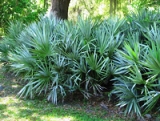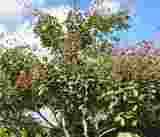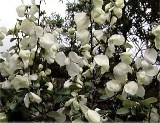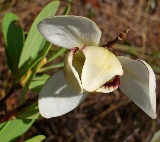Discover Florida Nature
It's time to explore the natural Florida


|
|
|
|
|
Palm Trees: Florida is home to a variety of native Palm
trees, including the fllowing: Florida
Royal Palm (Roystonea regia)- Truly an aristocrat of the plant
kingdom, this palm makes a memorable impression wherever it is grown.
Massive and symmetrical with a smoothly sculpted trunk this palm looks
almost artificial, like a denizen of an idealized Disney landscape. But
it is real and lends a distinctive air to parkways and boulevards all
over South Florida and the Caribbean. The Florida Royal Palm is native
to the cypress swamps of south Florida. It is disappearing from the wild
but nice stands can still be seen at the Royal Palm Visitors Center near
Homestead, Florida in the
Everglades National Park.
Royals like water and look their best when given adequate amounts. At
home in cypress swamps, the Florida Royal Palm tolerates occasional
flooding. Florida
Royal Palm (Roystonea regia)- Truly an aristocrat of the plant
kingdom, this palm makes a memorable impression wherever it is grown.
Massive and symmetrical with a smoothly sculpted trunk this palm looks
almost artificial, like a denizen of an idealized Disney landscape. But
it is real and lends a distinctive air to parkways and boulevards all
over South Florida and the Caribbean. The Florida Royal Palm is native
to the cypress swamps of south Florida. It is disappearing from the wild
but nice stands can still be seen at the Royal Palm Visitors Center near
Homestead, Florida in the
Everglades National Park.
Royals like water and look their best when given adequate amounts. At
home in cypress swamps, the Florida Royal Palm tolerates occasional
flooding. Saw
Palmetto (Serenoa repens)- Saw palmetto is a small hardy fan
palm whose stem usually remains below ground or runs just along the
surface. In some cases, it develops an arching trunk that may lift the
whorl of leaves 2-8 ft above ground. The fruits are round, black when
ripe and about an inch in diameter. Saw Palmetto Palm Tree likes full
sun but will tolerate some shade. It needs moderate watering but is very
tough in a drought conditions. The cluster of leaves gets about 4-6 ft
high with a similar spread. The leaf stems are about 2 ft long and
sharply saw-toothed. Saw
Palmetto (Serenoa repens)- Saw palmetto is a small hardy fan
palm whose stem usually remains below ground or runs just along the
surface. In some cases, it develops an arching trunk that may lift the
whorl of leaves 2-8 ft above ground. The fruits are round, black when
ripe and about an inch in diameter. Saw Palmetto Palm Tree likes full
sun but will tolerate some shade. It needs moderate watering but is very
tough in a drought conditions. The cluster of leaves gets about 4-6 ft
high with a similar spread. The leaf stems are about 2 ft long and
sharply saw-toothed. Paradise
tree (Simarouba glauca)- Paradise Tree is found in coastal
hammocks throughout South Florida, the Keys, the Caribbean and Tropical
America. Relatively fast growing, it is a common component of the upper
canopy, effortlessly reaching heights of greater than 40 feet. New
growth emerges as flames of red and gold. Paradise trees tend to grow
rapidly in the rainy season, and rest during periods of cool weather and
reduced sunlight. The paradise tree is a marvelous creation. It mops up
carbon dioxide and produces oxygen, its leaves provide shade and then
fall to the ground as life-giving mulch. Its deep roots prevent soil
erosion. Every part of the tree is used for medicinal purposes. Natives
use it to cure intestinal parasites, fevers, malaria, diarrhea,
dysentery, anemia, colitis, herpes, influenza, polio, West Nile virus
and other viruses, stomach and bowel disorders, as an astringent for
wounds and sores, to stop bleeding and as a tonic. It is currently being
studied as a toxin to cancer and leukemia cells. Paradise
tree (Simarouba glauca)- Paradise Tree is found in coastal
hammocks throughout South Florida, the Keys, the Caribbean and Tropical
America. Relatively fast growing, it is a common component of the upper
canopy, effortlessly reaching heights of greater than 40 feet. New
growth emerges as flames of red and gold. Paradise trees tend to grow
rapidly in the rainy season, and rest during periods of cool weather and
reduced sunlight. The paradise tree is a marvelous creation. It mops up
carbon dioxide and produces oxygen, its leaves provide shade and then
fall to the ground as life-giving mulch. Its deep roots prevent soil
erosion. Every part of the tree is used for medicinal purposes. Natives
use it to cure intestinal parasites, fevers, malaria, diarrhea,
dysentery, anemia, colitis, herpes, influenza, polio, West Nile virus
and other viruses, stomach and bowel disorders, as an astringent for
wounds and sores, to stop bleeding and as a tonic. It is currently being
studied as a toxin to cancer and leukemia cells.Pawpaw: Pawpaw is in the same family (Annonaceae) as the custard-apple, cherimoya, sweetsop, ylang-ylang and soursop, and it is the only member of that family not confined to the tropics.  Scrub
Pawpaw (Asimina obovata) -Sometimes called flag pawpaw, the
scrub pawpaw is restricted to scrubs in central and coastal peninsular
Florida. Scrub pawpaw is a shrub that resprouts after fire and reaches
up to 6-10' in height. The beautiful flowers are fragrant and up to 4"
across. They are followed by sweet, banana-like fruits up to 3" long
that are relished by wildlife. (Bet you can't find a ripe one!) The
foliage of all the pawpaws is malodorous and this one is no exception.
Cattle leave it alone, and often the only plants above ground level in a
pasture are the pawpaws. Scrub pawpaws bloom in the early spring and put
on quite a show! Scrub
Pawpaw (Asimina obovata) -Sometimes called flag pawpaw, the
scrub pawpaw is restricted to scrubs in central and coastal peninsular
Florida. Scrub pawpaw is a shrub that resprouts after fire and reaches
up to 6-10' in height. The beautiful flowers are fragrant and up to 4"
across. They are followed by sweet, banana-like fruits up to 3" long
that are relished by wildlife. (Bet you can't find a ripe one!) The
foliage of all the pawpaws is malodorous and this one is no exception.
Cattle leave it alone, and often the only plants above ground level in a
pasture are the pawpaws. Scrub pawpaws bloom in the early spring and put
on quite a show! Reticulate
Pawpaw (Asimina reticulata)- The reticulate pawpaw or Dog
banana is a deciduous shrub about four and one half feet tall. It is
densely branched and has oblong leaves that are alternate, leathery and
have rounded tips. The top of the reticulate pawpaw leaf is pale green
and the underside is grayish with reddish brown veins. Fragrant flowers
(singular or clustered) hang down from the upper leaf axils. They appear
mid-spring before or with the leaves and have six creamy white petals.
The three inner petals have purplish markings. The edible reticulate
pawpaw fruit is oblong and yellowish green. This pawpaw occurs in pine
flatwoods, coastal scrubs and sandhills in the central and southern part
of Florida. Reticulate
Pawpaw (Asimina reticulata)- The reticulate pawpaw or Dog
banana is a deciduous shrub about four and one half feet tall. It is
densely branched and has oblong leaves that are alternate, leathery and
have rounded tips. The top of the reticulate pawpaw leaf is pale green
and the underside is grayish with reddish brown veins. Fragrant flowers
(singular or clustered) hang down from the upper leaf axils. They appear
mid-spring before or with the leaves and have six creamy white petals.
The three inner petals have purplish markings. The edible reticulate
pawpaw fruit is oblong and yellowish green. This pawpaw occurs in pine
flatwoods, coastal scrubs and sandhills in the central and southern part
of Florida. |
|
|
Advertise | Privacy Statement | Dog Encyclopedia | Video |Contact | Alaska Nature |
|